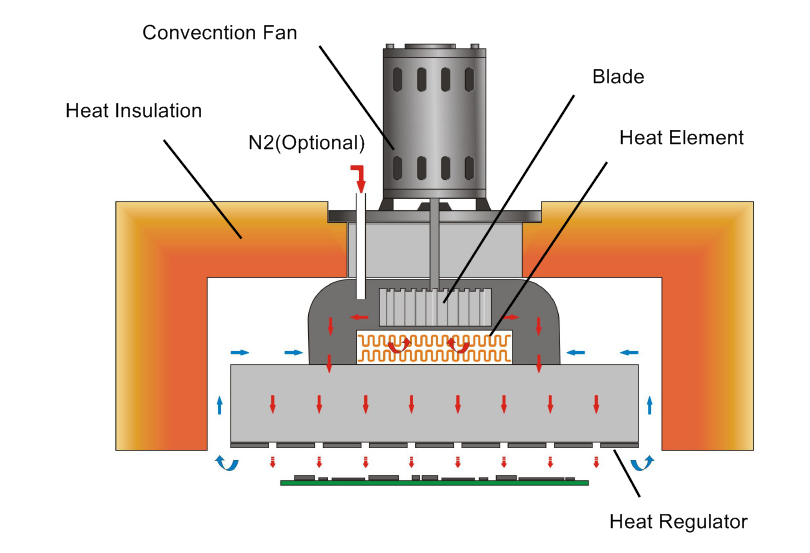Oxygen-reduced reflow ovens are a cornerstone of modern electronic manufacturing, ensuring precise soldering for components such as semiconductor devices and power packages. Among the critical parameters influencing the effectiveness of the reflow process, dwell time stands out as a crucial factor. This article explores the relationship between dwell time and oxygen-reduced reflow ovens, highlighting their significance and offering insights into optimizing the process.
What is an Oxygen-Reduced Reflow Oven?
An oxygen-reduced reflow oven is a specialized soldering system designed to create a controlled atmosphere with minimal oxygen during the soldering process. This low-oxygen environment is achieved by introducing inert gases, such as nitrogen or forming gas, which helps to reduce oxidation, improve solder quality, and ensure superior connections in electronic assemblies.
These ovens are widely used in applications such as semiconductor packaging, printed circuit board (PCB) assembly, and power device manufacturing, where precision and reliability are paramount.
The Role of Dwell Time in Oxygen-Reduced Reflow Ovens
Definition of Dwell Time
Dwell time refers to the duration that a solder joint or component remains at a specific temperature during the reflow process. In oxygen-reduced reflow ovens, this typically occurs at the peak temperature or during the soldering phase when the solder paste melts and forms reliable connections.
Importance of Dwell Time
· Solder Joint Quality: Proper dwell time ensures that the solder paste fully reflows, forming robust and consistent joints.
· Thermal Stress Mitigation: A well-controlled dwell time minimizes thermal stress on components, reducing the risk of damage or warping.
· Defect Reduction: Incorrect dwell time can lead to defects such as incomplete soldering, void formation, or excessive oxidation. In oxygen-reduced environments, these risks are significantly mitigated.
How Oxygen-Reduced Reflow Ovens Optimize Dwell Time
Uniform Temperature Control
Oxygen-reduced reflow ovens are equipped with advanced temperature profiling systems that maintain uniform heat distribution. This precision ensures that the dwell time for each component is consistent, reducing variability in solder joint quality.
Inert Atmosphere Benefits
By reducing oxygen levels, these ovens prevent oxidation during the dwell phase. Oxidation can compromise the wettability of the solder and lead to weaker joints. The inert environment enhances the effectiveness of the dwell time, allowing for superior solder adhesion.
Enhanced Process Control
Modern oxygen-reduced reflow ovens offer programmable profiles, enabling manufacturers to set precise dwell times tailored to specific materials and soldering requirements. This adaptability improves yields and reduces defects.
Factors Influencing Dwell Time in Oxygen-Reduced Reflow Ovens
1. Component Material and Size
Larger components may require longer dwell times to ensure uniform heating.
Materials with high thermal mass absorb heat more slowly, influencing the required dwell time.
2. Solder Paste Composition
Different solder pastes have varying melting points and flow characteristics. Selecting the right dwell time ensures proper reflow without overheating.
3. Temperature Profiles
An optimal reflow temperature profile typically consists of four stages: preheat, soak, reflow, and cooling. The dwell time occurs during the reflow stage and must be carefully synchronized with the other phases.
4. Inert Gas Flow Rate
The rate of inert gas flow in oxygen-reduced reflow ovens affects the uniformity of the low-oxygen environment. A stable atmosphere ensures that dwell time is utilized effectively to prevent oxidation.
Best Practices for Managing Dwell Time in Oxygen-Reduced Reflow Ovens
1. Conduct Thermal Profiling
Use thermal profiling equipment to map the temperature variations across the PCB or component. This ensures the dwell time is consistent across all solder joints.
2. Select the Right Inert Gas
Choosing the appropriate inert gas, such as nitrogen, and maintaining its flow rate is critical to maximizing the benefits of the oxygen-reduced environment.
3. Monitor Oxygen Levels
Advanced oxygen-reduced reflow ovens are equipped with oxygen level monitors. Maintaining oxygen levels below 100 ppm is ideal for most soldering processes.
4. Optimize Conveyor Speed
The conveyor speed in the reflow oven affects the overall heating time and dwell time. Adjusting the speed ensures components spend the optimal amount of time in each temperature zone.
5. Regular Maintenance
Clean and maintain the oven to ensure consistent heat distribution and gas flow, which are essential for achieving the desired dwell time.
Benefits of Using Oxygen-Reduced Reflow Ovens for Soldering
1. Improved Solder Joint Reliability
By minimizing oxygen exposure, these ovens reduce voids and enhance the structural integrity of solder joints, ensuring long-lasting connections.
2. Enhanced Yield Rates
Oxygen-reduced reflow ovens significantly decrease defects, leading to higher yields and reduced rework costs.
3. Versatility in Applications
These ovens are suitable for various applications, including semiconductor device packaging, power electronics, and high-frequency PCBs, where precision is critical.
4. Eco-Friendly Processes
Reducing defects means less material waste and fewer rework cycles, contributing to environmentally friendly manufacturing practices.
The Future of Oxygen-Reduced Reflow Ovens
As electronics manufacturing continues to demand smaller, more reliable components, oxygen-reduced reflow ovens are evolving to meet these needs. Innovations in temperature control, oxygen monitoring, and energy efficiency are paving the way for next-generation soldering solutions.
Chengliankaida Technology Co., Ltd., a leader in high-tech equipment manufacturing, is at the forefront of these advancements. With a commitment to innovation, the company is driving the development of more efficient oxygen-reduced reflow ovens, ensuring that manufacturers worldwide achieve optimal soldering performance.
Conclusion
Dwell time is a critical parameter in the soldering process, especially in oxygen-reduced reflow ovens. By providing a controlled low-oxygen environment, these ovens optimize dwell time, ensuring high-quality solder joints and reliable electronic assemblies. Whether you are manufacturing semiconductor devices or advanced PCBs, understanding and managing dwell time in an oxygen-reduced reflow oven is essential for achieving superior results.





Comments